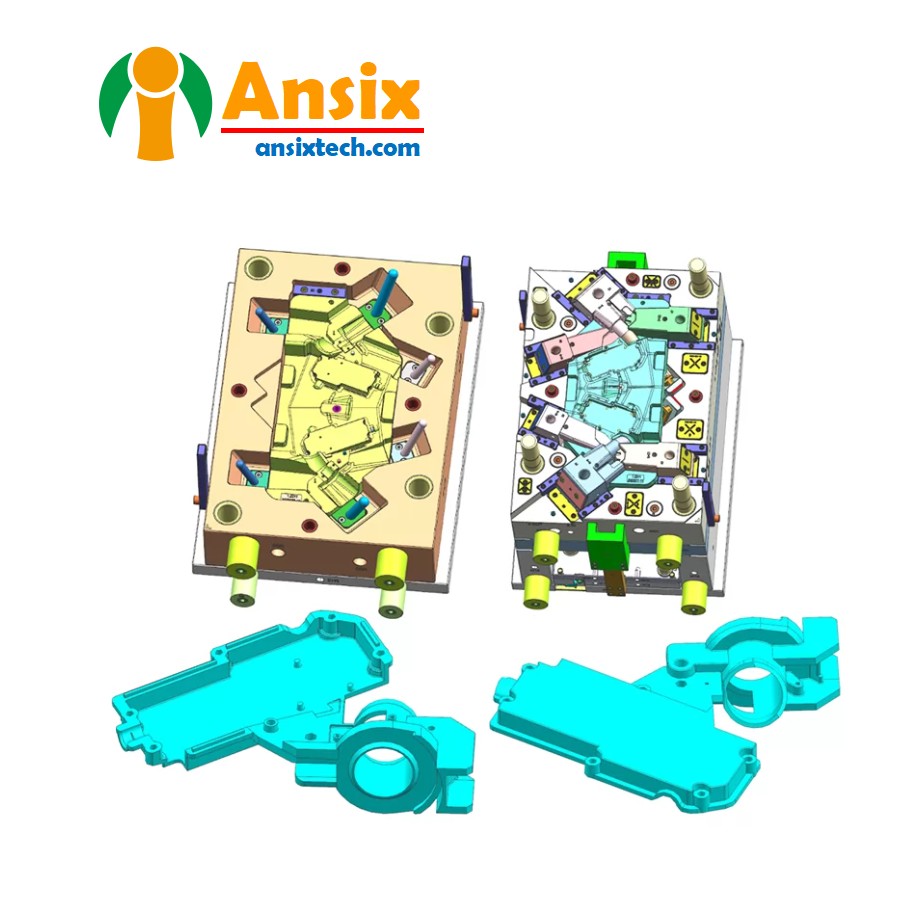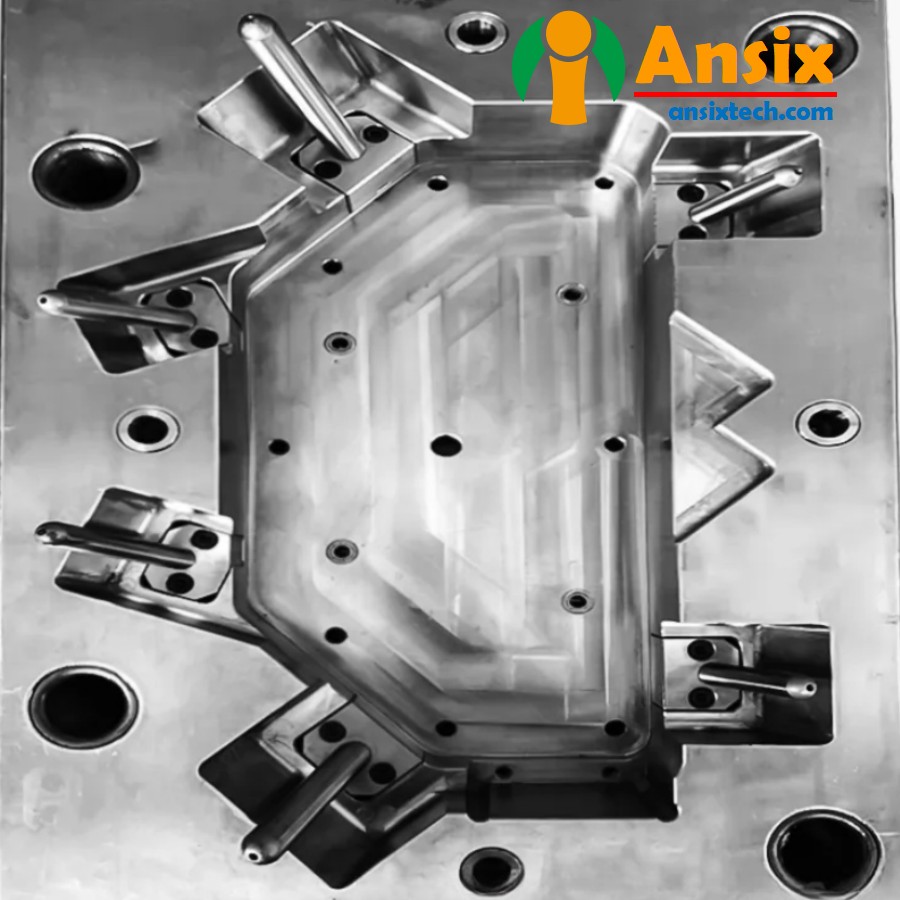Transparent Housing Plastic injection Mould Precision transparent parts
FEATURES
| Product Materials: | PC |
| Mold Material: | S136SER |
| Number of Cavities: | 1*2 |
| Glue Feeding Method: | Cold runner |
| Cooling Method: | Water cooling |
| Molding Cycle | 32.5s |
- Mold Marking Process


- Auto Parts Household appliances and consumer electronics Transparent Housing Mold flow analysis and mold designMold design and mold flow analysis for transparent housings for automotive parts, home appliances, and consumer electronics is one of the key steps in manufacturing these products.Mold design:Mold design is a key part of manufacturing transparent shells. During the design process, the following factors need to be considered:Appearance design: The appearance design of the transparent shell should conform to the overall style and aesthetic requirements of the product. Factors such as the shape, curves and details of the enclosure need to be considered.Internal structure design: The internal structure design of the transparent shell should consider the assembly and fixation methods of the product to ensure the stability and reliability of the components.Material selection: The material selection of the transparent shell should consider factors such as transparency, heat resistance and wear resistance. Commonly used materials include polycarbonate (PC) and polymethylmethacrylate (PMMA).Mold manufacturing process: According to the size and shape of the product, select the appropriate mold manufacturing process, such as CNC machining, EDM and wire cutting, etc.Mold flow analysis:Mold flow analysis is an important step in the mold design process. Through mold flow analysis, the flow of plastic during the injection molding process can be simulated to help optimize mold design and avoid defects such as bubbles, short shots, and warpage. Mold flow analysis can be carried out using professional mold flow analysis software. According to the geometry of the mold and injection molding process parameters, the flow of plastic in the mold is simulated and corresponding analysis results and suggestions are given. Through mold flow analysis, the design of the mold can be optimized to improve product quality and production efficiency.Mold manufacturing:According to the mold design and mold flow analysis results, the mold for the transparent shell is manufactured. Mold manufacturing needs to consider the following aspects:Mold material: Choose appropriate mold materials, such as high-quality alloy steel or stainless steel, to ensure the hardness and wear resistance of the mold.Mold processing: According to the mold design, CNC machining, EDM, wire cutting and other processes are performed to manufacture precision mold parts.Mold surface treatment: Surface treatment of the mold, such as polishing, coating and nitriding, etc., to improve the wear resistance and service life of the mold.Transparent housing mold design and mold flow analysis for automotive parts, home appliances, and consumer electronics products is one of the key steps in manufacturing these products. Through reasonable mold design and mold flow analysis, transparent shells with beautiful appearance and reliable quality can be manufactured. At the same time, attention needs to be paid to material selection, processing technology and surface treatment during the mold manufacturing process to ensure the quality and durability of the mold.
- Auto Parts Household appliances and consumer electronics Transparent Housing of the mold manufacturing process and product material selectionThe manufacturing and processing of transparent housing molds for automotive parts, home appliances and consumer electronics and the selection and application of transparent component materials are one of the key steps in manufacturing these products.Mold manufacturing and processing:Mold manufacturing processing is one of the key steps in manufacturing transparent housings. During the mold manufacturing process, the following aspects need to be considered:Mold material: Choose appropriate mold materials, such as high-quality alloy steel or stainless steel, to ensure the hardness and wear resistance of the mold.Mold design: Carry out mold design according to the size and shape of the product to ensure the accuracy and stability of the mold.Mold processing: According to the mold design, CNC machining, EDM, wire cutting and other processes are performed to manufacture precision mold parts.Mold surface treatment: Surface treatment of the mold, such as polishing, coating and nitriding, etc., to improve the wear resistance and service life of the mold.Transparent component material selection:The choice of transparent component material is crucial to the quality and appearance of the transparent housing. Commonly used transparent component materials include:Polycarbonate (PC): PC material has good transparency, heat resistance and impact resistance, and is suitable for manufacturing high-quality transparent shells.Polymethyl methacrylate (PMMA): PMMA material has good transparency and weather resistance, and is suitable for manufacturing transparent shells and transparent parts.Polystyrene (PS): PS material has good transparency and formability, and is suitable for manufacturing transparent shells and transparent parts.Material application:According to the specific requirements and application scenarios of the product, appropriate transparent component materials are selected for application. Common applications include:Auto parts: Transparent shells can be used in car dashboards, lights, rearview mirrors and other components to improve the appearance quality and safety of the product.Household appliances: Transparent shells can be applied to household appliances such as televisions, air conditioners, washing machines, etc. to improve the appearance quality and user experience of the product.Consumer electronics: Transparent shells can be applied to consumer electronics such as mobile phones, tablets, and headphones to improve the appearance quality and brand image of the product.The manufacturing and processing of transparent housing molds for automotive parts, household appliances and consumer electronics and the selection and application of transparent component materials are one of the key steps in manufacturing these products. Through reasonable mold manufacturing processing and transparent component material selection and application, transparent shells and transparent components can be manufactured with beautiful appearance and reliable quality.

- Auto Parts Household appliances and consumer electronics Transparent Housing Mass production and Quality controlThe mass production of transparent shell injection molding for auto parts, household appliances and consumer electronics involves many aspects such as production efficiency improvement, automated tooling and fixture configuration, cost control and process quality assurance.Improvement of production efficiency:In order to improve production efficiency, the following measures can be taken:Automated production line: Introduce automated equipment and production lines to improve production efficiency and stability.Process optimization: Optimize injection molding process parameters, such as injection speed, temperature control, etc., to improve production efficiency and quality.Parallel production: Parallel production is adopted to carry out multiple processes at the same time to shorten the production cycle.Automated tooling and fixture configuration:By configuring automated tooling fixtures, production efficiency and product quality can be improved, and reliance on manual operations can be reduced. Automated tooling fixtures can achieve the following functions:Automatic loading and unloading: Automatic loading and unloading is realized through automated devices, reducing manual operation time.Automatic positioning and clamping: Automatic positioning and clamping of products are achieved through automated fixtures, improving production efficiency and product consistency.Automatic detection and elimination: Automatic detection and elimination of products are realized through automated devices to improve product quality and production efficiency.Cost control:In the mass production process, cost control is required to reduce production costs. Common cost control measures include:Raw material cost control: Select appropriate raw material suppliers, conduct cost negotiation and optimization, and reduce raw material costs.Labor cost control: Optimize the production process, improve production efficiency, and reduce manual operation time and labor costs.Equipment cost control: Reasonably select equipment suppliers, control equipment procurement and maintenance costs, and reduce equipment costs.Process quality assurance:During mass production, process quality assurance is required to ensure product consistency and stability. Common quality assurance measures include:Quality control plan: Develop a quality control plan to clarify the quality requirements and control methods for each link.Inspection and testing: Conduct product inspection and testing, such as appearance inspection, dimensional measurement, functional testing, etc., to ensure that the product meets the requirements.Process monitoring: Monitor the production process, such as temperature control, injection pressure control, etc., to ensure product consistency and stability.To sum up, the mass production of transparent shell injection molding for auto parts, household appliances and consumer electronics products involves many aspects such as production efficiency improvement, automated tooling and fixture configuration, cost control and process quality assurance. Through reasonable measures and management, production efficiency can be improved, costs can be reduced, and product quality and stability can be ensured.





